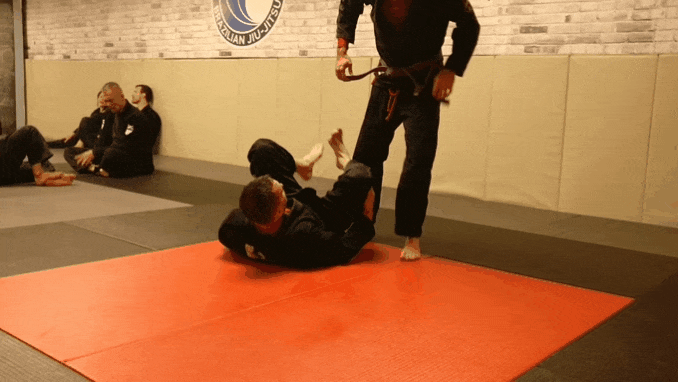The reverse De La Riva guard is it's own guard as much as the De La Riva guard is, but at the same time, they are really a system you are going to implement together. It is difficult to really use either of them effectively without using the other in at least some spots. RDLR plugs some of the holes in DLR. The main objective of DLR to turn the knee in exposing the back although it is not limited to this. Unfortunately, DLR is also weak to the knee cut when done properly. The main objective of RDLR is to turn the knee out, stopping the knee cut. They are two sides if the same coin.
The key thing is to note the similarities as much as the differences. In both there is an active hook and an active post. The gripping can vary significantly depending on what the guard player intends to do, but generally it is desirable to control the ankle of the leg we are actively hooking.
In DLR the outside leg is the hooking leg and the inside leg is the post, usually on the far leg. Additionally the guard players hip is inside their opponents foot.
In RDLR the inside leg becomes the hooking leg and the outside leg the posted leg, usually on the near hip. Also, the guard players hip moves outside their opponents foot.
De La Riva Guard
Reverse De La Riva Guard
Right off the bat, much of what we covered in in the DLR section is directly applicable to RDLR. Our sickle sweep, hook sweep, and arm drag can be slotted in with very little change. Some of these are even easier from RDLR.
The sickle sweep from DLR requires that we switch our hips a bit to get power from our bottom leg, in RDLR we are already closer to this position. Whats more, our posting leg is already on the hip making for one less adjustment. All that we really require is to get our bottom hand to the far ankle. This sweep is a mainstay of RDLR.
The Hook sweep is similar to the sickle sweep but we keep our hand grip on the near ankle then drop our hook and reach it to the far ankle. This can be easier and stronger if we almost invert on to our bottom shoulder, lifting our hip off the ground.
The arm drag is also easier from RDLR than from DLR. Much like before we want to drop the inside leg low, turn our hips ninety degrees so that our belly button is facing the far leg and place our head in the ribs. Continuing to pull the arm out in front of their face in order to off balance them as well as to prevent feeding the overhook counter to our single. We drive with our head hard to shift the weight to the far leg, making it easier to get to our feet and pick up the leg we are attacking.
For new material we looked at getting the fishing pole grip. This grip is essentially a far side wrist grip with our bottom arm, and a far side armpit grip with our top arm. It is called a fishing pole grip because we want to pull the top grip to us and push the bottom grip away, as if you were fighting a heavy fish. Getting this grip not only steals the base from from our opponents far arm, but it also gives us strong ability to load their weight on top of our hook and force them into a shoulder roll type shape. That said, we need to make sure that the planes they are vulnerable in match the planes we can generate force through. So it is often needed to remove our posting leg from the hip, place it on the ground to shrimp and realign our hook to make sure we can kick them directly toward the trapped shoulder and over our own head. After they hit the ground our own shoulder roll should bring us to cross body side control, or occasionally mount.
If we work for the fishing pole grip one thing we may encounter is that the posting leg might move from the hip down inside. This might be something we initiate as a bait, or it might be something our opponent does in order to begin a pass toward the back. Once the post is cleared the pass is a real concern and we need to realign. A top player looking to move toward our back is likely to sprawl and attempt to smash our legs to the side. Once they start moving to do so, we need to turn what was out posted leg into a butterfly hook, point the knee far to the outside. Once here, we are essentially in the more conventional half butterfly version of the fishing pole sweep. The direction of the sweep is once again directly over our own head, and a shoulder roll will usually bring us on top. That said, sometimes we can drive our chest forward to win the beginning of a back take.
There will be more on RDLR as we progress so stayed tuned.









